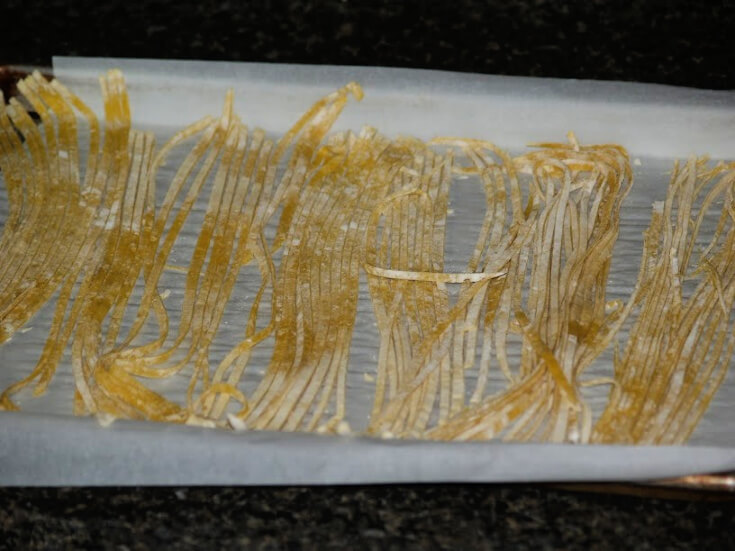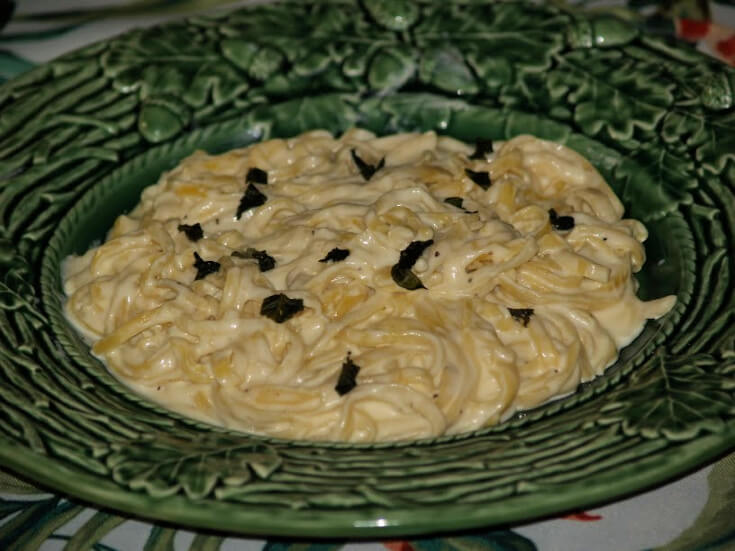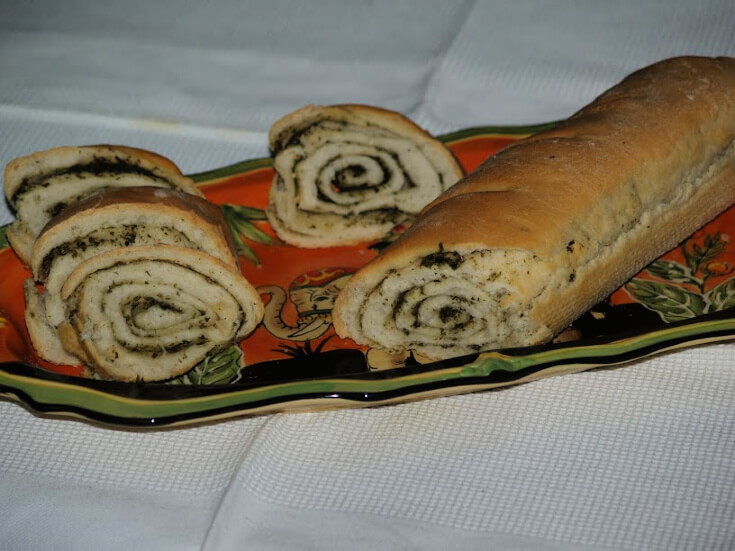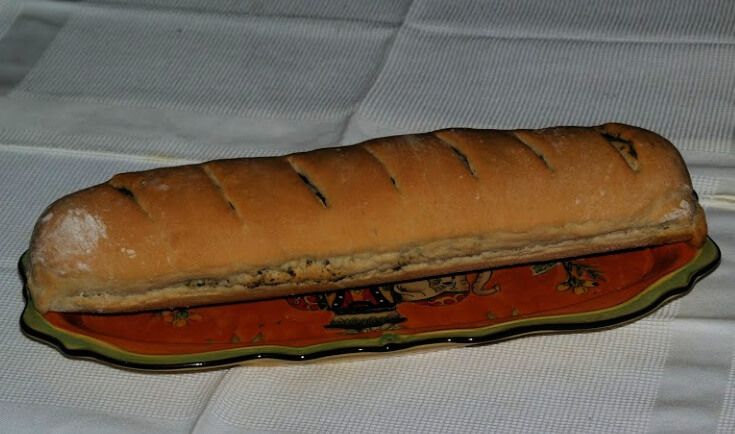- Painless Cooking
- International Foods
- Traditional Italian Food
Traditional Italian Foods
The main focus of traditional Italian foods is the “food” itself. Was the recipe made with the best quality ingredients? Fruits and vegetables have the best taste when eaten in season promptly after harvesting. Game and other meats are more flavorful when cooked fresh. The taste of seafood really diminishes each day it is refrigerated.
Most of us familiar with the Italian cuisine know that Italy is known for its many types of pasta (Fresh and dried) and breads. Many of these recipes are the traditional recipes pasted down through family members. These are some of my favorite recipes. I love all the wonderful breads from the crusty loaves, flavorful flat breads to stuffed breads filled with cheeses, olives, vegetables and meats.
Although traditional Italian foods do include these two groups that is not all. As here in America, today Italy imports many cooking ingredients which were not available for the older traditional recipes. These older recipes were made with the local ingredients. This accounted for a fresher taste but also is the reason why the different regions are known for their own dishes. Below is a list of regions giving some of the traditional foods.
ABRUZZI: Traditional Italian foods of this mountain region is known to be hearty and filling. Fresh pork, vegetables and local cheese head the list. Coastal area also includes fresh fish from area.
AOSTA VALLEY: Mountainous region known for its game and rich Fontina cheese.
APULIA: Area surrounded by water so the mainstay is fish and seafood usually fried in local olive oil.
BASILICATA: Poor area where main production is olive oil. Cooking includes oil and many spices.
CALABRIA: Traditional Italian foods of this poor area include dried pasta, citrus, seafood and vegetables.
CAMPANIA: Area of water for plenty of seafood; clams, squid, mussels. There are also dishes made with dried pasta, olive oil, tomatoes and other vegetables, garlic, oregano and cheeses such as Mozzarella and provolone.
EMELIA ROMAGNA: Known for rich cuisine using butter, cream and Parmesan cheese. Diets also include sausages, cured meats, balsamic vinegar and freshly made pasta.
FRIULI VENEZLA GLULIA: Not really known for its food but for white wine; will find many recipes using ham and seafood.
LATIUM: Region of Rome, famous for its food. Popular foods include Roman cheese, suckling pig and lamb and fettuccini.
LIGURIA: Coastal region known for its pesto sauce and seafood especially mussels.
Traditional Italian foods of the LOMBARDY Region (includes Milan) is famous for its polenta and risotto.
MARCHES: Varied diet not well known to the outside world; anything from fish soup to suckling pig.
PIEDMONT: Northern area known for being wine country and its white truffles, slender breadsticks of Turin and anchovy garlic dip.
SICILY: Known for wide array of foods; olive oil, dried pasta, tomatoes, eggplant, peppers, seafood, hot red pepper, ice cream and desserts.
TRENTINO ALTO ADIGE: Located near Austria and Switzerland serving more of a German style cuisine; apple strudel, fresh pork, smoked meats, sauerkraut and white wines.
Traditional Italian foods of TUSCANY are known for hearty bean soups and home of Chianti wine.
UMBRIA: Known for black truffles, pork, pork sausages and for light wine.
Traditional Italian foods of VENETO (Includes Venice) are famous for Scamp recipes, fish soups and liver with onions.
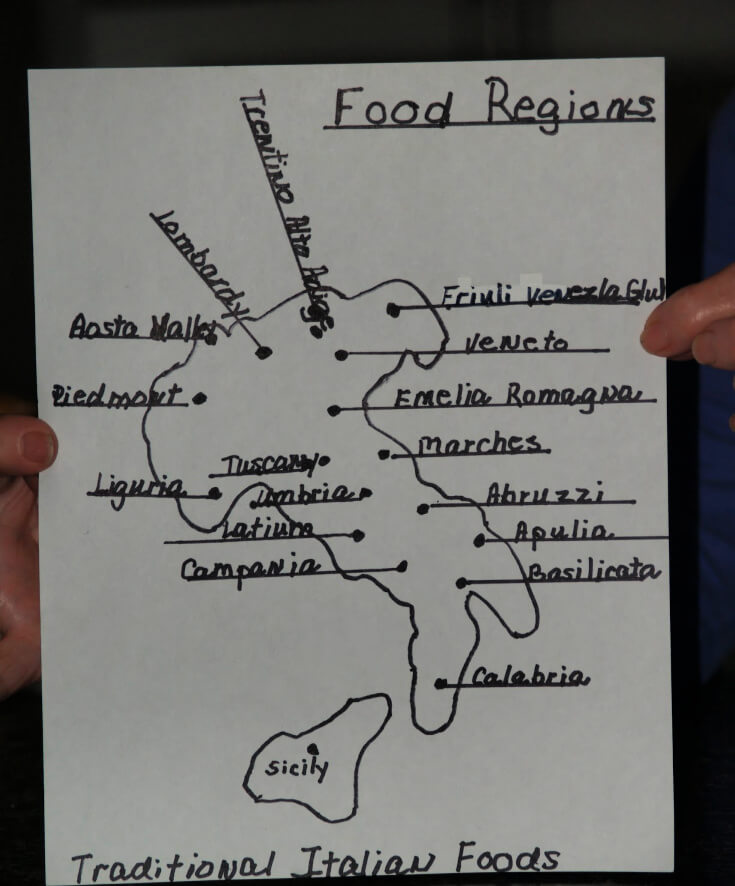 Food Regions of Italy
Food Regions of ItalyCREAMY FETTUCCINI ALFREDO
Recipes including butter, cream, cheese and fresh pasta are traditional Italian foods of Emilia Region.
- 8 Ounces cream cheese (Cubed)
- ¾ Cup grated Parmesan cheese
- ½ Cup butter
- ½ Cup milk
- 8 Ounces fresh fettuccini (Cooked)
In a large saucepan combine cream cheese, Parmesan cheese, butter and milk.
Stir over low heat until smooth; add fettuccini and toss lightly.
Serves 4.
ITALIAN HERB BREAD RECIPE
Traditional Italian foods always include delicious breads in all regions of Italy.
- 1 Cup water
- 2 Tablespoons vegetable oil
- About 3 ½ cups flour (Divided)
- 1 Package dry yeast
- 1 Tablespoon sugar
- 1 Teaspoon salt
Herb Butter Filling
- ¼ Cup softened butter
- 1 Teaspoon garlic powder
- 2 Tablespoons parsley flakes
- 1 Tablespoons chives
- 1 Teaspoon seasoned salt
FOR DOUGH heat water and oil to 120F degrees.
In a mixing bowl combine 1 ½ CUPS of flour, yeast, salt and sugar.
Add water mixture beating on low speed of mixer scraping sides until blended.
Continue mixing adding more of the flour until a soft dough forms.
Turn out onto floured surface; knead until smooth and elastic.
Place dough in a greased bowl; cover and let rise until doubled about 1 hour.
Punch dough down; roll out to a rectangle 15 X 18 inches.
Combine all FILLING ingredients together until smooth.
Spread over rectangle to within 1 inch of edges.
Roll rectangle up jelly roll style pinching edges to seal.
Place seam side down on baking sheet sprinkled with cornmeal.
Slash top several times diagonally with a sharp knife.
Cover and let rise until doubled in bulk about 1 hour.
PREHEAT OVEN TO 375F degrees.
Bake for 15 minutes; REDUCE HEAT to 350F degrees.
Bake 20 to 25 minutes longer.
SICILIAN CAPONATA RECIPE a Traditional Italian Food
Traditional Italian foods of Sicily include eggplant, tomatoes and other vegetables.
- 2 Medium eggplants (Unpeeled/ chopped into ½ inch cubes)
- Salt
- Vegetable oil
- 2 Medium onions (Chopped)
- 4 Ribs celery (1/2 Inch slices)
- 3 cups Italian plum tomatoes (Chopped)
- 1 Teaspoon sweet basil
- 1 Teaspoon salt
- 1/8 Teaspoon pepper
- ½ cup capers (Optional)
- 1 Cup green olives (Chopped)
- 1 Tablespoon sugar
- 3 to 4 Tablespoons red wine vinegar (To taste)
Place eggplant in colander; sprinkle with salt.
Place plate inverted over eggplant; weight down with heavy object.
Let stand about 1 hour; rinse thoroughly, drain and dry on paper towels.
Heat 2 TABLESPOONS oil in Dutch oven; add onion and celery sautéing 5 minutes.
Add tomatoes, basil, salt and pepper; simmer 10 minutes.
Add capers and olives; cook 5 minutes longer.
In large skillet heat some oil; fry eggplant in small batches until browned.
Drain eggplant on paper towels; add eggplant to tomato mixture.
Add sugar and vinegar; stir and simmer for 8 to 10 minutes.
Store in jars in refrigerator for up to 2 weeks; makes about 9 cups.
RISOTTO CABRILLO RECIPE
Traditional Italian foods of the Northern Lombardy Region include risotto.
- 3 Cups chicken broth
- 1 ½ Cups short grain rice (Not cooked)
- ½ Cup chopped onion
- 2 Tablespoons melted butter
- 3 Tablespoons olive oil
- 3 Medium tomatoes (Diced)
- 2 Cups fresh spinach (Chopped)
- 1/3 Cup shredded carrot
- 1/3 Cup shredded zucchini
- 3 Green onions (Chopped)
- 1 Ounces dried porcini mushrooms (Stemmed)
- ¼ Cup dry white wine
- ¼ Cup heavy cream
- 1 Teaspoon dried basil
- ¾ Cup freshly grated Parmesan cheese
- ¼ Teaspoon salt
- 1/8 Teaspoon pepper
Bring chicken broth to a boil in a small saucepan.
Cover, reduce heat to low and keep warm.
Melt the butter in a 3 quart saucepan; add rice and onion.
Cook over medium high heat for 8 minutes stirring constantly.
Add 1 ½ cups of chicken broth to the rice stirring well.
Cover, reduce heat and simmer 10 minutes.
In a large skillet combine oil, tomatoes and next 5 ingredients.
Cook and stir over medium high heat for 8 minutes until crisp tender.
Add remaining chicken broth, vegetables, wine, cream and basil to rice.
Stir well, cover and simmer 10 minutes or until most of liquid is absorbed.
NOTE: Stir 2 times during cooking.
Stir in cheese, salt and pepper; serves 6 to 8.
ITALIAN BAKED OYSTERS
Lots of seafood is typical of the traditional Italian foods of Campania Region.
- Rock salt
- 3 Tablespoons Italian dressing
- 2 Teaspoons lemon juice
- ¼ Teaspoon hot sauce
- 2 Tablespoons Italian seasoned breadcrumbs
- 1 Tablespoon Grated Parmesan cheese
- 1/8 Teaspoon garlic powder
- 1/8 Teaspoon dried Italian seasoning
- 12 Medium size fresh raw oysters (On half shell)
- 1 Tablespoon minced fresh parsley
Preheat oven to 425F degrees.
Sprinkle a thin layer of rock salt in a shallow baking pan.
Combine Italian dressing, lemon juice and hot sauce; set aside.
Combine breadcrumbs and next 3 ingredients; set aside.
Place oysters (in shells) over the rock salt.
Sprinkle oysters evenly with Italian dressing and breadcrumb mixtures.
Bake 6 to 8 minutes or until edges of oysters begin to curl.
Sprinkle with fresh chopped parsley; makes 1 dozen.
GNOCCHI RECIPE
Gnocchi is among the traditional Italian foods introduced by the Romans.
- 1 Quart milk
- 1 Cup coarse semolina
- Salt/ pepper
- Grated nutmeg
- 1 ½ cups grated Parmesan cheese (Divided)
- 1 Egg yolk
- 2 Tablespoons milk
Heat milk just to boiling in a heavy saucepan.
Sprinkle in the semolina; season with salt, pepper and nutmeg.
Cook gently stirring for 4 to 5 minutes until mixture becomes solid.
Remove pan from heat; beat in 1 CUP of the cheese.
Pour onto a greased jelly roll pan; cool about 1 hour.
NOTE: Do not refrigerate.
PREHEAT OVEN TO 400F degrees.
Cut the cooled mixture into about 20 rounds (2 ½ Inches in diameter).
Arrange the rounds (Overlapping) in a greased round ovenproof dish.
Beat eggs and milk and pour over top; sprinkle ½ CUP cheese on top.
Bake for 30 minutes until golden brown; serve immediately.
ITALIAN SAUSAGE with fennel and garlic
Traditional Italian foods of the Umbria Region include deliciously flavored sausages.
- 2 Pounds lean pork (Cut in 1 inch chunks)
- 6 to 8 Ounces pork fat (Cut in 1 inch chunks)
- 4 Cloves garlic (Mashed)
- 2 Tablespoons fennel seed (Bruised0
- 1 ½ Teaspoons salt
- 1 Teaspoon paprika
- 1/8 Teaspoon cayenne pepper
Combine ingredients in food processor; chop coarsely first.
Next chop with a finer blade (OR you can grind).
Mix lightly; seal in tight container and place in refrigerator.
NOTE: Flavor will improve after a few hours.
Use in recipes or make sausage patties.
PEACH TART RECIPE
Traditional Italian foods include peach desserts from the regions of Campania and Emilia Romagna.
- 6 Tablespoons butter
- ½ Cup sugar
- 3 Eggs
- 1 ¼ Cups flour (Sift)
- Grated rind 1 lemon
- 16 Ounces canned sliced peaches
- ½ Cup hazelnuts (Finely chopped)
Preheat oven to 350F degrees.
Grease and line 8 inch spring form pan.
Cream butter and sugar together until fluffy.
Beat in the eggs one at a time beating after each.
Fold in sifted flour and lemon peel with metal spoon.
Pour in mixture and smooth top.
Drain peaches thoroughly, arrange in circle on top cake mixture.
Sprinkle hazelnuts over the top; bake 45 minutes.
Cool to warm; run knife around edges to loosen.
Remove sides from pan; place on warmed serving plate.
Serve warm with cream if desired.
STRAWBERRIES ZABAGLIONE RECIPE
In regions like Basilicata, Campania, Veneto, Piedmont and Emilia Romagna you can find strawberries in recipes for traditional Italian foods.
- 2 Egg yolks
- 2 Tablespoons sugar
- 2 Tablespoons Marsala wine
- 1 cup heavy whipping cream
- ¼ Cup sifted powdered sugar
- 2 ½ to 3 Dozens strawberries (Wash and cap)
Combine the egg yolks, 2 tablespoons sugar and wine in top of double boiler.
Beat on medium speed of mixer until blended; place over boiling water.
Reduce heat to low; cook about 5 minutes or until soft peaks form.
NOTE: Beat constantly on medium speed of mixer.
Remove from heat; spoon mixture into a bowl placed in larger bowl of ice.
Beat mixture until cool about 3 minutes; refrigerate for 30 minutes.
Combine heavy cream and powdered sugar; refrigerate 30 minutes.
Add heavy cream mixture to the yolk mixture; beat until stiff.
Make 2 perpendicular slices down pointed end of each strawberry.
NOTE: The slices will cross separating the berry into quarters. Cut to within ½ inch of stem end of each berry.
Gently spread out quarter sections of each berry.
NOTE: Be careful not to break pieces off. You want to make a small “cup” in the center of berries.
Fill a pastry bag with the cream mixture; fill each strawberry “cup”; refrigerate.
Makes about 30 to 34 filled berries.
GARLIC PORK ROAST RECIPE
Traditional Italian foods from the Trentino Alto Region have a strong German influence utilizing a lot of pork and potatoes.
Pork Roast
- 1 Boneless pork roast (2 ½ to 3 Pounds)
- ½ cup minces fresh parsley
- 2 Tablespoons minced fresh rosemary
- 3 Cloves minced garlic
- Salt/ pepper
- 3 Tablespoons extra virgin olive oil (Divided)
Preheat oven to 375F degrees.
Slice open the roast like a jelly roll to lay flat on cutting board.
*See page Example of Jelly Roll Technique
Combine and mix parsley, rosemary, garlic, ¾ teaspoon salt and ¾ teaspoon pepper.
Blend in 2 TABLESPOONS of the olive oil; spread over the flat meat leaving ½ inch on sides.
Roll meat up like a jelly roll; tie together with meat string.
Brush rolled roast with remaining 1 Tablespoon olive oil; sprinkle with salt and pepper.
Place on rack in shallow pan; roast about 60 to 75 minutes until meat is done.
Let rest 15 minutes; remove string, slice and serve.
Serves 4 to 6.
ROSEMARY POTATOES
- 2 Pounds red potatoes (Wash, dry, quarter; NOT peeled)
- 2 Cloves minced garlic
- ¼ Teaspoon salt
- ½ Teaspoon dried thyme
- 1 Tablespoon olive oil
- 2 Teaspoons chopped fresh rosemary
- 1/8 Teaspoon pepper
Preheat oven to 450F degrees.
Combine all ingredients in a large bowl.
Add potatoes; toss with fork to coat.
Arrange potatoes in well greased baking pan (9X13 inch).
Bake uncovered for 40 minutes until potatoes are tender.
Serves 4.
